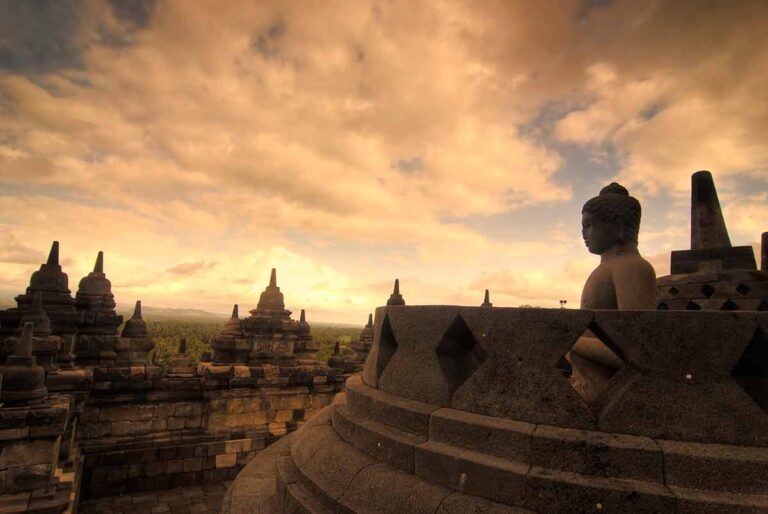Asia is the world’s largest continent, covering a third of the globe and home to over 60% of the world’s population. Bordered by three oceans (Indian, Arctic and Pacific), two seas (Black and Caspian) and two mountain ranges (the Ural and Caucasus), Asia has some of the largest and fastest-growing cities in the world. Think Shanghai, Mumbai, Tokyo and Seoul.
Some of the world’s most popular items originated in Asia, including tea, paper, umbrellas, fireworks and gunpowder. Asia is home to impressive shrines, Christian churches and ancient Buddhist and Hindu temples. From Angkor Watt and Borobudur to the Great Wall of China, with 54 countries and territories, there are so many landmarks in Asia for your bucket list. Here are our top 20.
20 Famous Landmarks in Asia
Famous Landmarks in Asia
1- Great Wall of China
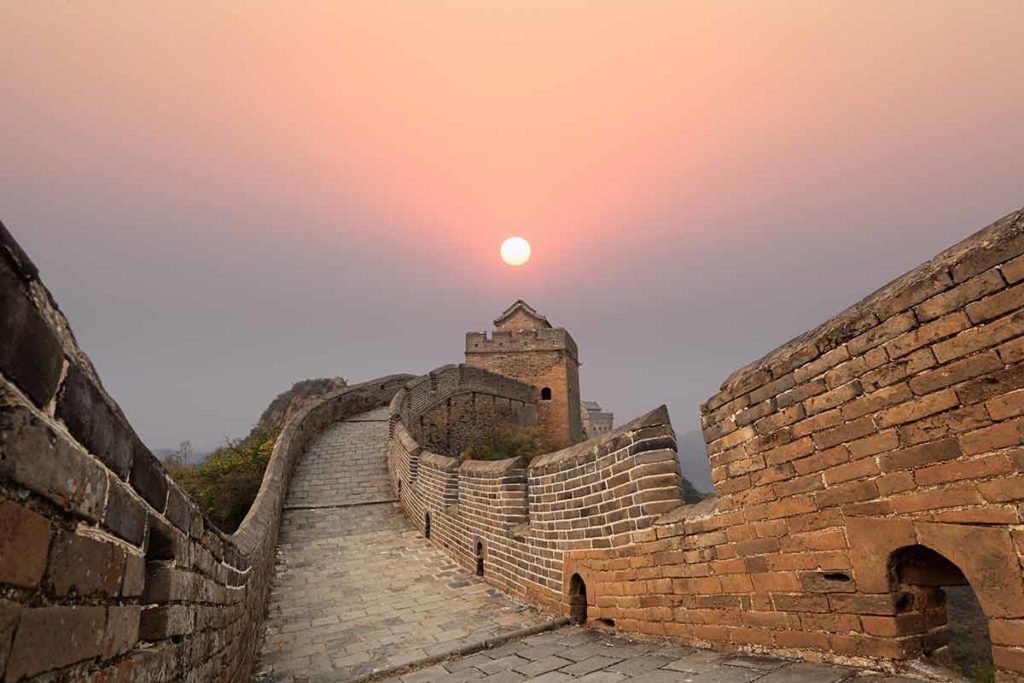
 The Great Wall of China is one of the most famous landmarks of Asia.
The Great Wall of China is one of the most famous landmarks of Asia.
With a 4000-year-old culture, from palaces and temples to natural wonders, China is home to some of the most impressive landmarks in Asia.
It’s a nation that is hurtling towards the future at high speed, with impressive new engineering feats popping up each year.
The 500-year-old Great Wall of China is one of the most famous landmarks of Asia and according to Chinese astronaut Yang Liwei who orbited in 2003, it can’t be seen from the moon.
The structure is a collection of walls, towers, fortresses and barracks stretching 21,196km (13,171 miles).
The section of the Great Wall that receives the most visitors are Badaling and Mutianyu near Beijing.
You can explore this famous landmark in Asia as a day trip from the capital.
2- Angkor Wat
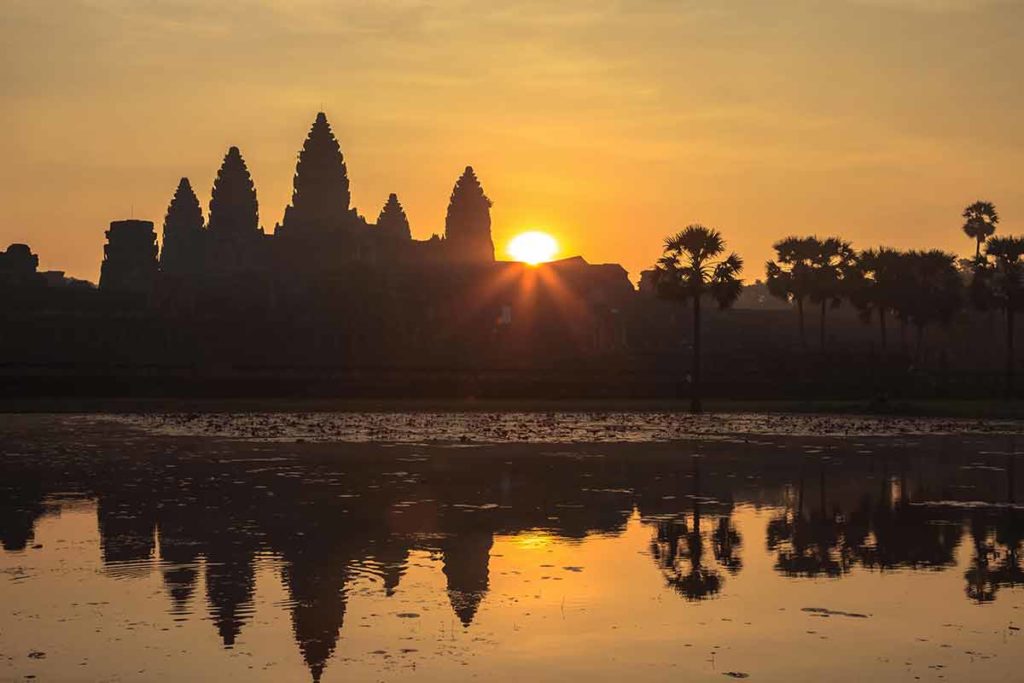
 Angkkor Wat is a stunning Asian landmark to visit.
Angkkor Wat is a stunning Asian landmark to visit.
The 12th century Angkor Wat is possibly the largest religious landmark in the world.
Built in northern Cambodia by Emperor Suryavarman II, initially as a Hindu temple in the 12th century, Angkor Wat became a Buddhist temple when King Jayavarman VII turned to Buddhism following the sacking of Angkor by the Cham in 117.
An icon on the flag of Cambodia, Angkor Wat means ‘city of temples’ in the Khmer language.
Of all the buildings in this sprawling UNESCO World Heritage site, its famous five towers are the most impressive.
What was the largest city in the world before industrialisation, Angkor Wat is not only a great Asian landmark but one of the most well-known around the world.
3- Borobudur
You may be surprised to learn that Borobudur is the world’s largest Buddhist monument.
Located in Indonesia’s island of Java, the 9th-century temple has nine platforms and a distinctive dome.
Six of those platforms are square and three circular, giving it architecturally interesting angles influenced by India’s Gupta architecture.
Aside from the structure, the most impressive attractions in Borobudur is its 504 statues of Buddha and the 2,672 bas relief panels.
The location of the Mahayana Buddhist temple is as awe-inspiring as the structure itself, standing out like a mystical Asian landmark on a hilltop surrounded by green fields.
4- Petronas Twin Towers
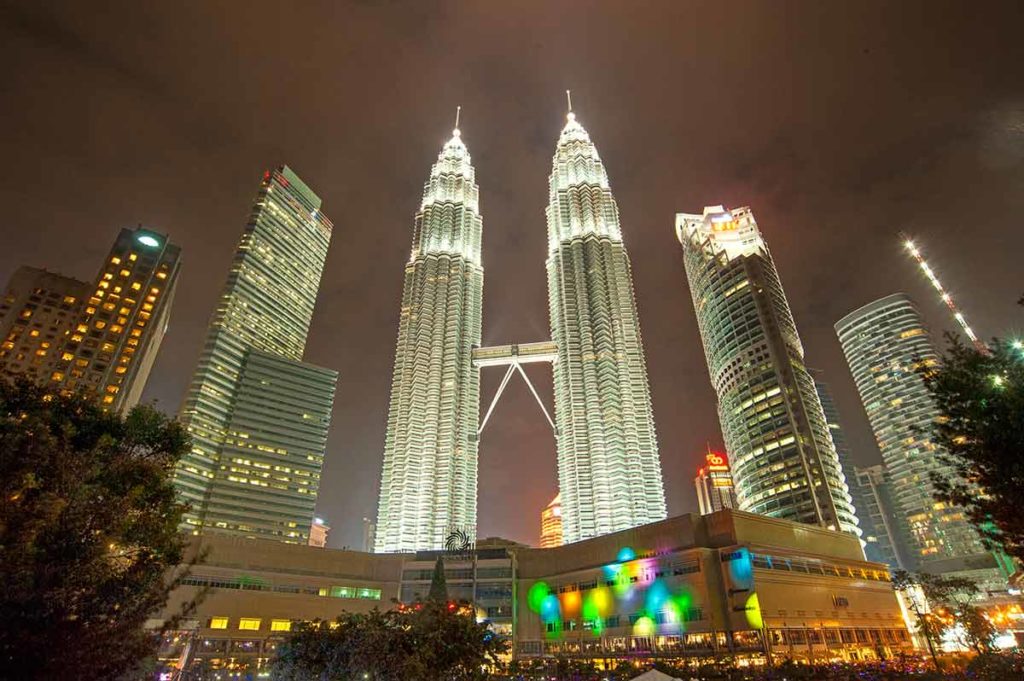
 Kuala Lumpur is home to one of the most famous landmark buildings in Asia.
Kuala Lumpur is home to one of the most famous landmark buildings in Asia.
Malaysia is a multicultural melting pot of Malay, Indian and Chinese cultures, with incredibly tasty food and lush landscapes.
Although there its rich biodiversity has endowed it with plenty of natural attractions, the most famous landmark in this Asian country is a manmade marvel.
Standing above the skyline of the nation’s capital, the Petronas Twin Towers is the world’s tallest twin towers (451.8 m).
They took six years to build and were designed by César Pelli who created this masterpiece using Islamic concepts and geometric forms, including that of the eight-pointed star.
The observation decks on the 86th floor of both towers are connected by a bridge and have stunning views over Kuala Lumpur.
5- Marina Bay Sands
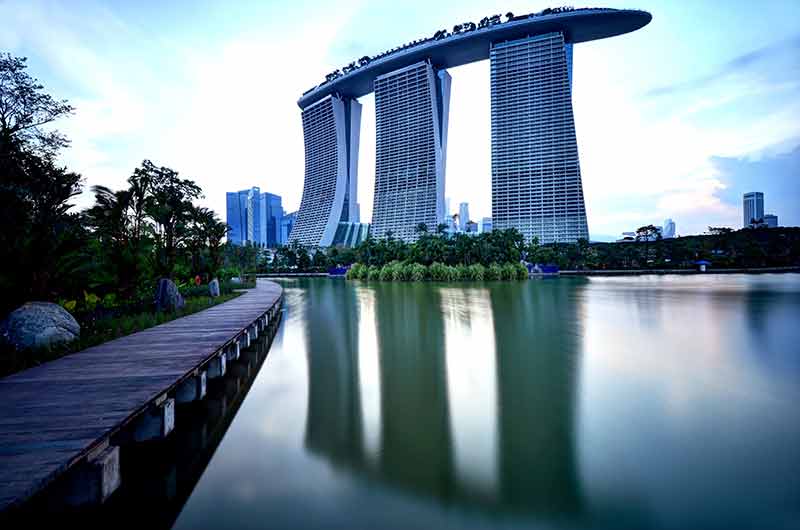
 Another Asian landmark to see is Marina Bay Sands in Singapore.
Another Asian landmark to see is Marina Bay Sands in Singapore.
Although Singapore is rich in colonial history, one of the most stunning architectural landmarks in this country is a contemporary building that dominates the skyline.
Marina Bay Sands is a modern ‘ship’ in the sky with amazing views of the island city.
Not only is it a landmark in Asia to go and see but you can also stay in it as inside, there’s luxurious accommodation, shopping and stunning infinity pools to.
Designed by well-known architect Moshe Safdie, this architectural monument has three 55-storey towers with the Sands SkyPark balanced across the towers.
6- Shibuya Crossing
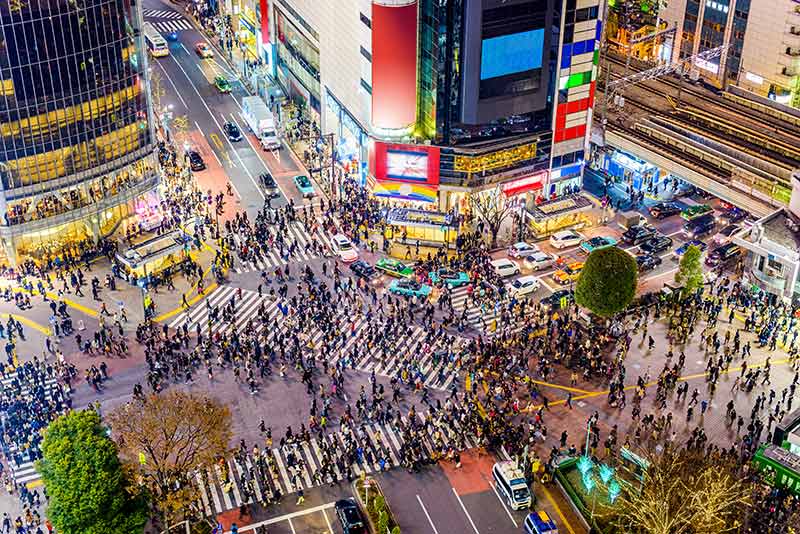
 The most vibrant Asian landmark is Shibuya Crossing in Japan.
The most vibrant Asian landmark is Shibuya Crossing in Japan.
A country in Asia that leads the world with cutting-edge technology, Japan is also a place where ancient traditions are well preserved.
With a treasure trove of ancient castles, shrines and temples, there’s no shortage of historical landmarks in this Asian country to admire, and there are thousands of city and country landmarks to see.
As Japan’s megacities are growing at lightning speed, one of the unique landmarks in Asia is the Shibuya Crossing because over 250,000 people scramble across it every day.
You can watch the crowds from the second floor Starbucks in the Shibuya Tsutaya building or brave it yourself on foot.
The experience is exhilarating as you walk alongside thousands of pedestrians while flashing billboards and skyscrapers tower overhead.
Shibuya Crossing is a landmark in Asia that everyone knows and it is held in such high esteem that some even choose to propose to their loved ones here.
7- The Grand Palace
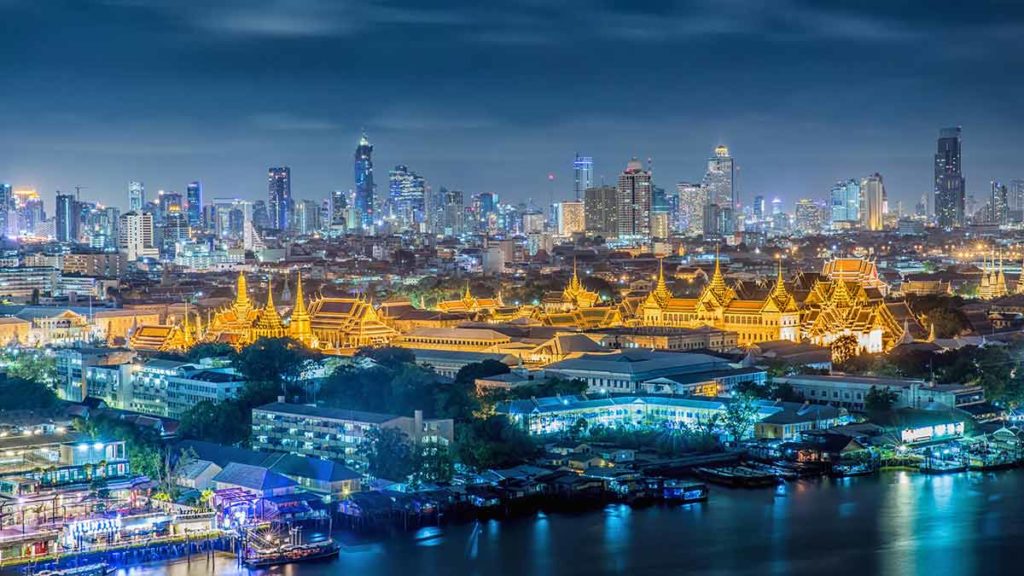
 Thailand’s Grand Palace is another famous landmark to tick off your Asia list.
Thailand’s Grand Palace is another famous landmark to tick off your Asia list.
Thailand’s rich heritage has bestowed upon its temples and palaces, many of which are stunningly beautiful.
Unlike the rest of Southeast Asia, the Kingdom of Thailand managed to evade European colonisation.
The result is Thailand’s culture remained intact and its palaces and temples are as impressive as they were in the past.
Of all the structures in Thailand, the Grand Palace in Bangkok is the one monument that stands out.
The former residence of Thailand’s Royal Family was turned into a museum and is one of the most famous landmarks in Thailand.
What began as a timber palace built by King Rama I in 1782, has grown into an impressive collection of buildings.
The Emerald Buddha in Wat Phra Kaew is an iconic monument in Asia within the Grand Palace, which is also a sacred site (so dress modestly when visiting).
8- Taj Mahal
The Taj Mahal is Many the most iconic monument in Asia and has awed millions of visitors.
The marble monument was built out of love by Mughal Emperor Shah Jahan for his wife Mumtaz Mahal, who died in childbirth.
The stunning architectural landmark is a 17ha complex that sits on the bank of the Yamuna River in Agra and houses the tombs of Shah Jahan and Mumtaz Mahal.
Twenty-eight types of jewels are embedded in the marble, including Tibetan turquoise and Chinese jade.
Twenty thousand labourers from all over Asia built this incredible monument and over 1,000 elephants transported the construction materials.
Sadly, Shah Jahan’s son imprisoned him in 1658 and he was only allowed to see the Taj Mahal from his window for eight years before being entombed there.
9- Abhayagiri in Anuradhapura
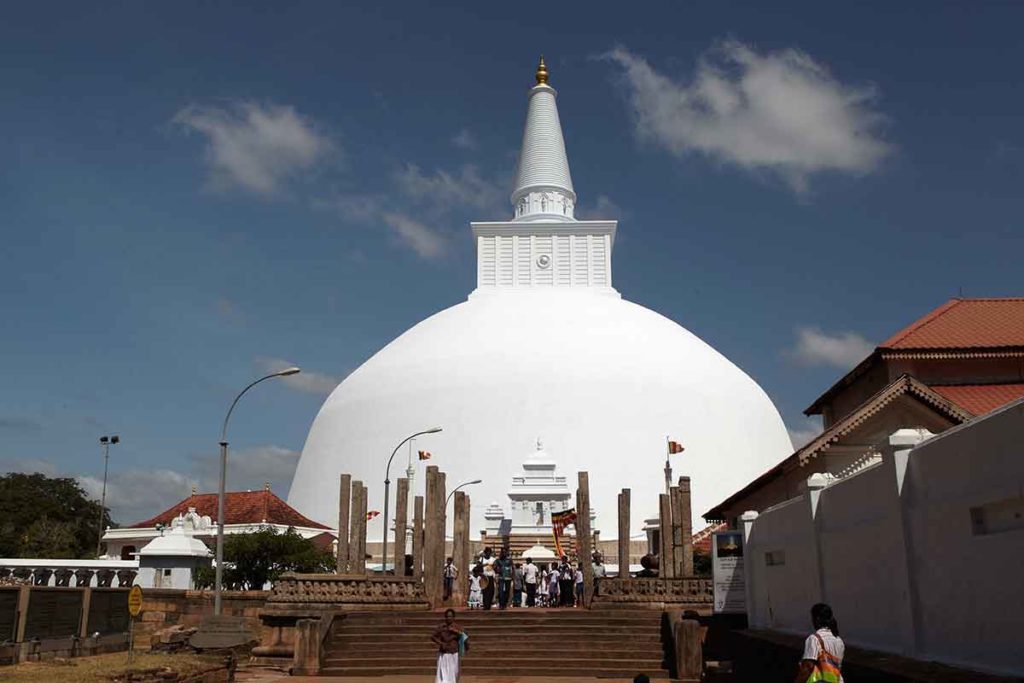
 Anuradhapura is one of the most impressive historical landmarks in Asia.
Anuradhapura is one of the most impressive historical landmarks in Asia.
The Sinhalese kings built temples of Anuradhapura from the fourth century BC to the 11th century AD.
Massive dagobas, stupas and soaring brick towers are some of the impressive architectural wonders in this World Heritage site.
Anuradhapura was not only the capital of the Sinhalese rulers, but it was also the centre for Theravada Buddhism for centuries.
This ancient city was one of the oldest cities in the world to be continuously inhabited.
There are four stupas in Anuradhapura – Jetavana, Ruyanvelisaya, Mirisavati and Abhayagiri.
Abhayagiri is 75m (it was initially 100m) tall and was built during the 1st century BC.
This enormous dagoba in Sri Lanka was a wonder of the ancient world and is as impressive as the Egyptian pyramids.
10- Taipei 101
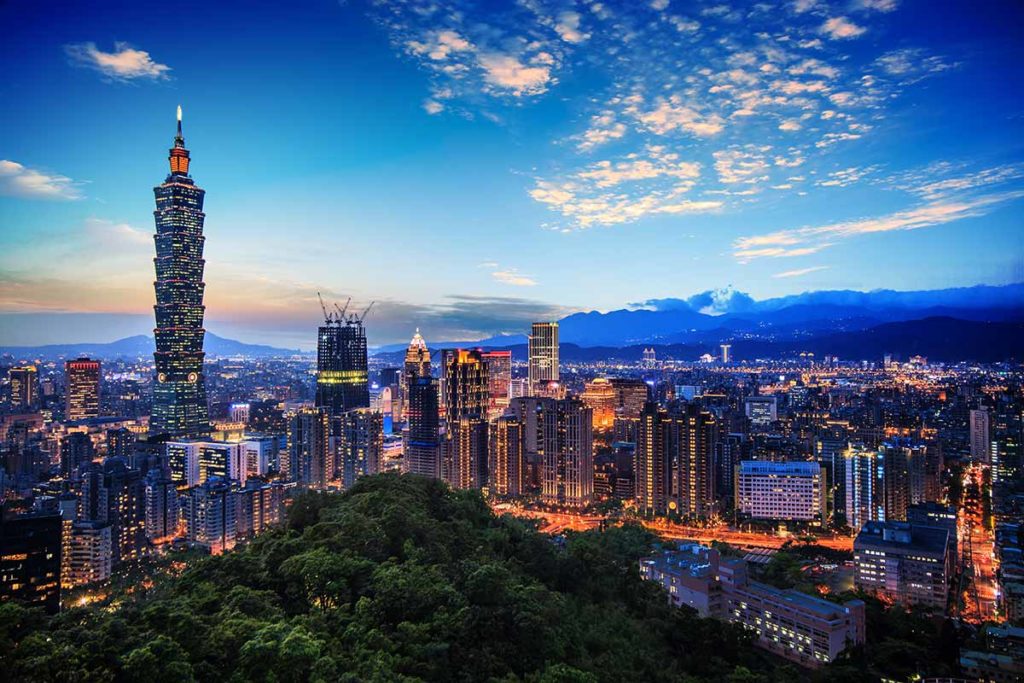
 Towering above the Taipei skyline is a major Asian landmark.
Towering above the Taipei skyline is a major Asian landmark.
One of the world’s tallest buildings, Taipei 101 is a famous contemporary monument of Asia that graces the Taipei skyline.
Even though it is futuristic, the 101-storey glass structure looks a bit like a traditional Taiwanese pagoda and is a sight to see when visiting Taiwan.
The high-speed elevator zips you up to the 89th-floor observatory in 37 seconds, and the view from here over Taipei City is expansive.
It’s worth walking one floor down to take a look at the giant wind damper used to keep the building upright and to offset the high winds.
This Asian landmark building was the tallest in the world between 2004 and 2010.
Natural Landmarks of Asia
11- Mount Kinabalu
Malaysia’s tallest mountain, Mount Kinabalu is 4095 m (13,438 feet) high and part of the Crocker Mountain Range.
Located in Sabah in East Malaysia, the area around the mountain is a landscape of rare plants (there are 5000 species of plants found here), and the jungles are home to tropical birds.
Hiking to the summit of this famous landmark in Asia, which is also a World Heritage site is not a walk in the park but the rewards are worth the effort.
Along the way, you’ll see rainforests of bamboo and massive tree ferns, where gibbons and orangutans live in the wild.
The views, of course, is spectacular from the top, and once you’ve made it to the pinnacle, you’ll see why this mountain is an attraction to climb.
British climber Hugh Low was the first person recorded in the history books to climb the mountain in 1851.
These days, only 130 people are allowed on the mountain each day.
12- Mount Krakatoa
A unique aspect about Indonesia is that part of the country is in the northern hemisphere and part is in the southern hemisphere.
A country with thousands of islands and one-third of the volcanoes in the world, it’s not surprising one of the most famous landmarks is a mountain.
Mount Krakatoa might not be the tallest or largest volcano in the land but it’s world-famous for erupting spectacularly in 1883, killing more than 36,000 people and destroying hundreds of villages and towns.
Remember the B-52’s song “Lava”?
The stratovolcano on Krakatoa Island is a conical volcano with steep sides and a famous Asian landmark that juts out of the Sunda Strait.
13- Mount Fuji
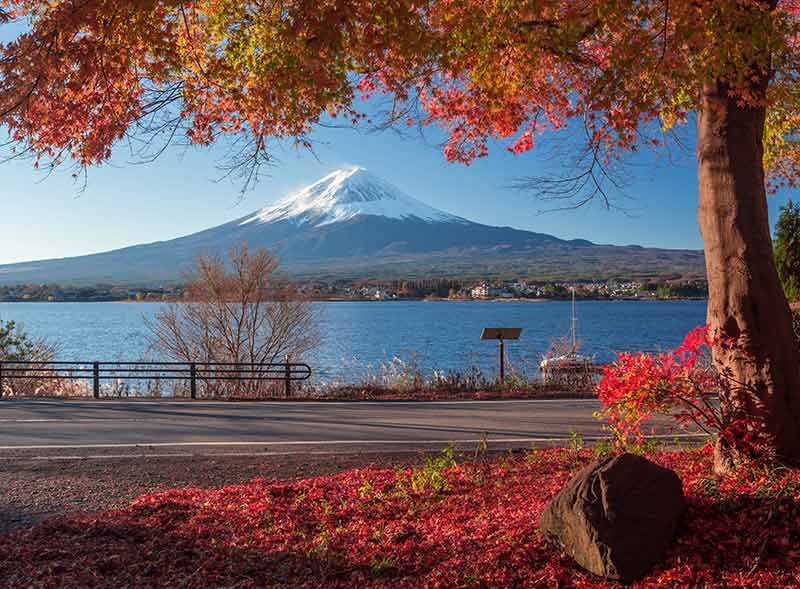
 Mount Fuji is one of the most stunning natural landmarks in Asia.
Mount Fuji is one of the most stunning natural landmarks in Asia.
Another famous landmark in Asia, Mount Fuji, has inspired poets and artists since the beginning of time.
A popular place to see Japan’s highest and most famous mountain is in Hakone, where you can soak in an onsen while gazing at snowcapped mountain views.
You can view the highest mountain in Japan from lots of vantage points around Tokyo, but to experience Mount Fuji, you need to climb it.
Mount Fuji is on the island of Honshū is 3,776 m high, and in Asia, it is the second-highest volcano on an island.
The seventh-highest island peak in the world, Mount Fuji is an active stratovolcano 100 km from Tokyo.
It last erupted in 1708.
14- Chocolate Hills
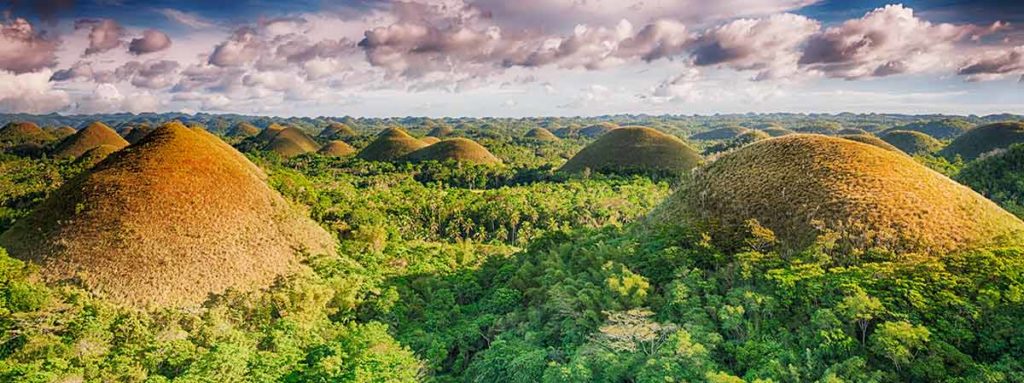
 The Chocolate Hills in the Philippines are famous Asian landmarks you will love.
The Chocolate Hills in the Philippines are famous Asian landmarks you will love.
Another Asian country with thousands of islands and active volcanoes, the Philippines is also home to a famous landmark in Asia that is neither an island nor a volcano.
Thousands of symmetrical hills in the Bohol Province of the Philippines are unique landmarks on the landscape.
Known as the Chocolate Hills, for its dry brown grass, these limestone hills have dome-like peaks of varying heights.
According to a local legend, these strange landmarks were created by a feud between giants who threw boulders at one another.
The scientific explanation is Chocolate Hills are conical karsts created when limestone was eroded by rain, flooding, rivers and streams.
For more amazing European Landmarks, read:
Monuments in Asia
15- Merlion
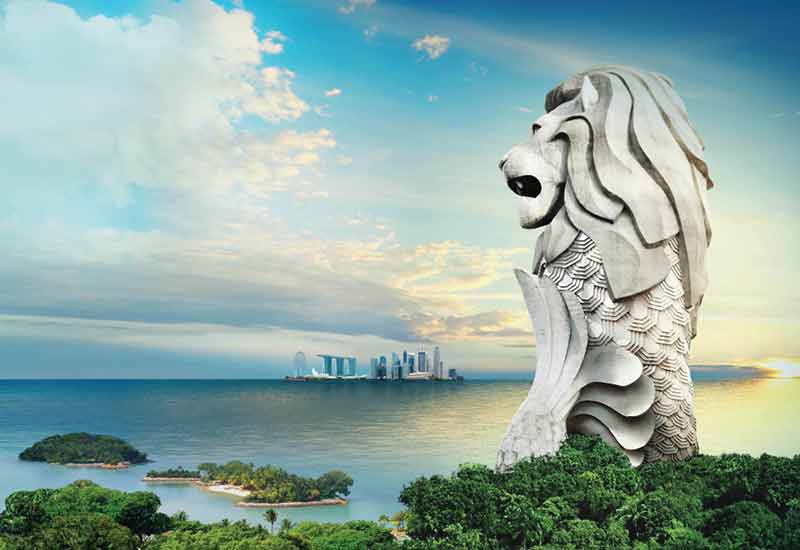
 One of the most famous monuments of Asia is the Merlion.
One of the most famous monuments of Asia is the Merlion.
As Singapore was a British colonial trading post, its legacy of colonial architecture combined with contemporary architecture, makes it an intriguing place to explore.
Singapore is also home to one of the most famous monuments in Asia, the Merlion.
The mythical mermaid cum lion guards the island in Merlion Park and continues to intrigue visitors with its legend.
According to the legend, a Malaysian prince came across a lion on an undiscovered island called Temasek (fish town).
He was inspired to change the island’s name to Singapura (lion city) in Sanskrit.
The Merlion monument became a reality in 1964 and is one of the most famous monuments in Asia.
16- Rizal Monuments
The Jose Rizal Memorial Protected Landscape ( or Rizal Park to the locals) is home to several Jose Rizal statues.
The 60 ha park is a lovely escape with ponds, lawns, ponds, gardens and trees dotted with statues of Filipino heroes.
Jose Rizal was the leader of the Propaganda Movement and a political activist who fought for the rights of the Philippines.
His execution by the Spanish rulers in the park where these statues stand turned him into a martyr and inspired opposition to Spain’s rule.
The statues are monuments in Asia that represent the freedom of the people.
Historic Landmarks in Asia
17- Cu Chi Tunnels
From pagodas and temples to caves and mountains, Vietnam is one of Southeast Asia’s most beautiful countries with many impressive landmarks to see.
However, the event of the Vietnam War created a unique landmark in Asia called the Cu Chi Tunnels.
The tunnels formed part of a network of tunnels that allowed the Viet Cong to travel underground.
As the war progressed, the tunnels expanded and became safe underground quarters for villagers to hide.
These days, you can crawl through some of the safer tunnels, visit command centres and learn more about the difficulties faced by the Vietnamese soldiers.
18- Atomic Bomb Dome
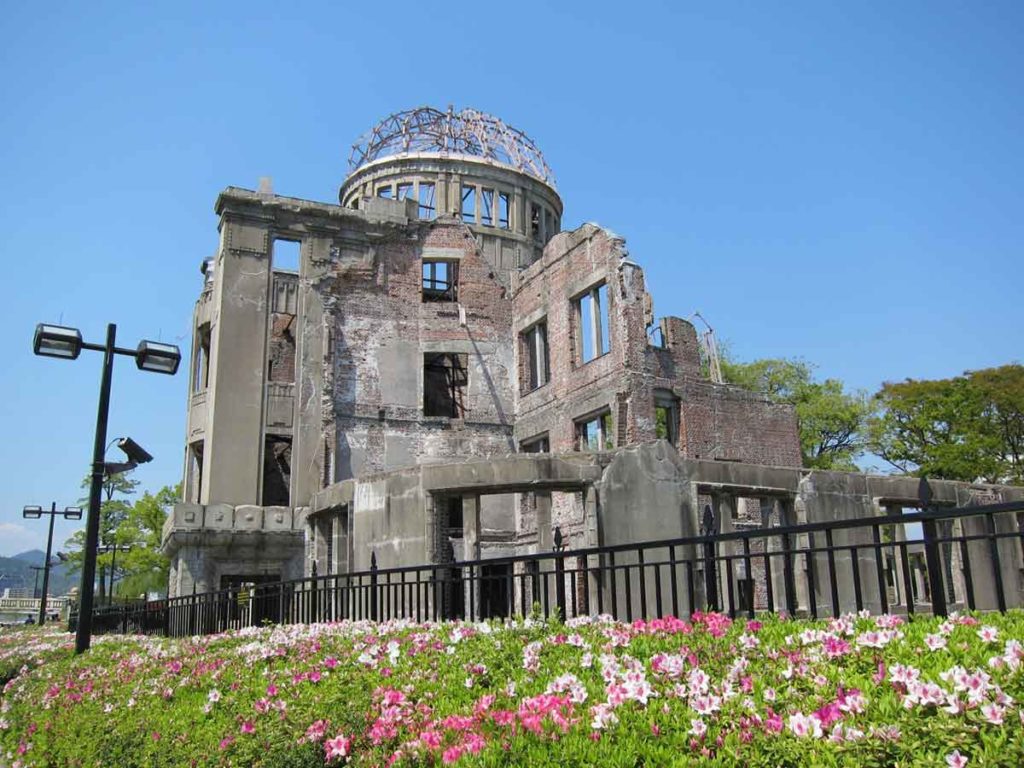
 The Atomic Bomb Dome is a significant Asia landmark of war.
The Atomic Bomb Dome is a significant Asia landmark of war.
On 6 August 1945, the first atomic bomb was dropped in Japan on the city of Hiroshima.
The Atomic Bomb Dome (A-Bomb Dome) is one of the best landmarks of Asia that is a reminder of a historical event that changed the world.
Located in Hiroshima’s Peace Memorial Park, the Atomic Bomb Dome was directly beneath the explosion and was a commercial hub before it was bombed.
Exploring at 600m in the air, the blast from the atomic bomb exerted 35 tons of pressure per square meter.
The dome absorbed the explosion and burst into flames, but miraculously, because the blast came from overhead, the steel dome wasn’t destroyed.
The USA chose this site as they believed that there were no American prisoners of war held captive in Hiroshima.
It’s now a UNESCO World Heritage Site.
19- DMZ
The war between North and South Korea occurred in 1950 when the north invaded the south.
The Soviet Union supported the North Koreans while South Korea was an ally of the USA.
Created in 1953 because of the Korean War, the demarcation line on the Korean peninsula that divides between North and South Korea is known as the demilitarised zone (DMZ).
The DMZ is 240km (150 miles) long and was created by the removal of forces 2km (1.2 miles) on each side.
Within the DMZ, the truce village of P’anmunjŏm is where discussions about peace were held.
20- The Ruins of St Paul’s
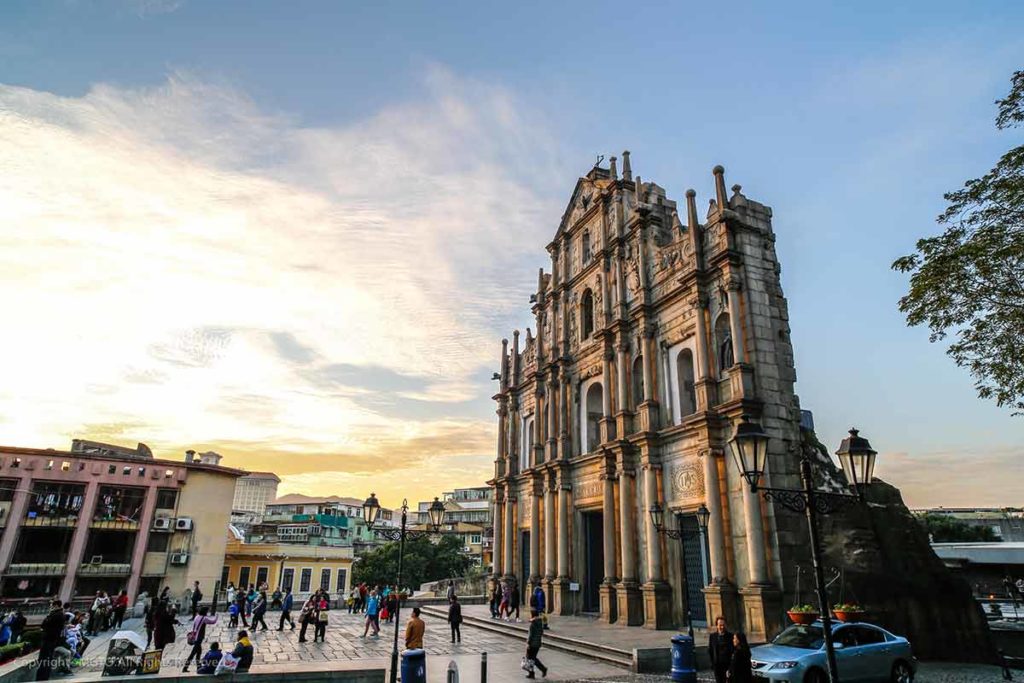
 St Paul’s Ruins is one of the monuments of Asia you need to visit.
St Paul’s Ruins is one of the monuments of Asia you need to visit.
Packed with Chinese temples and European churches, the Historic Centre of Macao is a UNESCO World Heritage site filled with wonders.
In contrast to the 21st-century contemporary Asian landmarks that are redefining the skyline, St Paul’s Cathedral is one of the landmarks of Asia deeply rooted in European history.
The Ruins of St. Paul’s are the remains of the 17th-century church that was destroyed by a fire in 1835.
The façade has carvings of a skeleton, Portuguese frigate and the Virgin Mary carved by Chinese stonemasons and Japanese Christian exiles.
There’s a crypt with the bones of 17th-century Japanese and Vietnamese Christian martyrs, and the Museum of Sacred Art is also at the Ruins of St Paul’s.
More famous landmarks around the world

